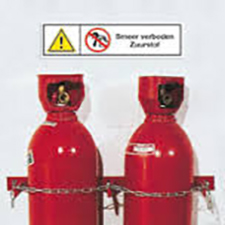Page content
Risks

Depending on the type of gas, a fire or explosive situation can occur (hydrogen gas, acetylene or propane) or a health-damaging situation (carbon dioxide or anesthetic gases). Gases that are not toxic themselves can be dangerous because they can displace oxygen. This happens, for example, with nitrogen and helium.
In addition to the (dangerous) properties of the gas itself, the high pressure is also a risk. In a gas cylinder, the gas is under (very) high pressure (200 - 300 bar). Incorrect use of the pressure regulator or dropping, heating or rusting through the cylinder can cause the gas cylinder to shoot away like a projectile or even explode. This means that good safety measures are required when using and transporting gas cylinders and when storing gases.
Which gases
In a umc, gases are used for different purposes. There is a distinction between:
- Technical gases: these are used for non-medical applications and in laboratories, among other things. For example, carbon dioxide and nitrogen.
- Medical gases: These are used in the treatment of patients. For example, oxygen and anesthetic gases.
Reducing risks
According to PGS 15, the storage of gas cylinders must be stored in a fire safety cabinet if the total volume of the gas cylinders in the room exceeds 125 litres. To work safely, the following measures and facilities are required:
- Properly secure gas cylinders during stationary storage, use, and movement, to prevent damage. Do this in (movable) racks or against a wall.
- Full cylinders may be stored up to a volume of 125 litres. If the storage is larger, an extracted fire safety cabinet must be used.
- Make sure the gas cylinders are in good technical condition and have them periodically inspected by the supplier.
- Do not use damaged gas cylinders or gas cylinders that have expired in the inspection period. Do not store them and dispose of them as soon as possible.
- Make sure that the valves of gas cylinders are well protected against damage that could release a gas.
- Protect gas cylinders from heating, heating or adverse weather influences.
- Do not install gas cylinder batteries at the workplace if they contain flammable, toxic, asphyxiating or oxygen-enriching gases. Set them up in a room that can only be accessed from the outside.
- Provide ventilation in the open air or mechanical ventilation of installation rooms containing gas cylinders containing flammable, poisonous, asphyxiating or oxygen-enriching gases. Provide these spaces on the outside at the entrances with a hazard symbol with the appropriate subtext. Examples include 'flammable gases smoking and open flames prohibited', 'poisonous, intoxicating, suffocating gases' or 'oxygen-enhancing gases smoking and open flames prohibited'.
- Ensure that the electrical installation is explosion-proof in areas for flammable gases.
- Do not store gas cylinders in the vicinity of basements, basements, wells, sewers and other areas below ground level, in which the gas can accumulate.
- In the vicinity of gas cylinders, make sure you have an easily accessible extinguisher that is well protected against weather influences. You can choose from the following devices:
- a dry powder extinguisher with a capacity of at least 6 kg of extinguishing powder
- a CO2 extinguisher with an extinguishing equivalent of 6 kg of powder
- Store oxygen cylinders separately from gas cylinders for flammable gases.
- Make sure that the connection of an oxygen cylinder to a piping system is such that no other gas cylinders can be connected to it.
- Do not use flammable packaging and grease for oxygen cylinder valves.
- Do not use copper (or alloys containing more than 63% copper) for pipes and fittings that may come into contact with acetylene. Ensure that gas cylinders containing extremely toxic substances, such as arsine and phosphine, are equipped with two independent block-in valves during intermediate storage and use. Store these in separate rooms. Prevent employees from being exposed to gases or vapours in the ORs as much as possible.
